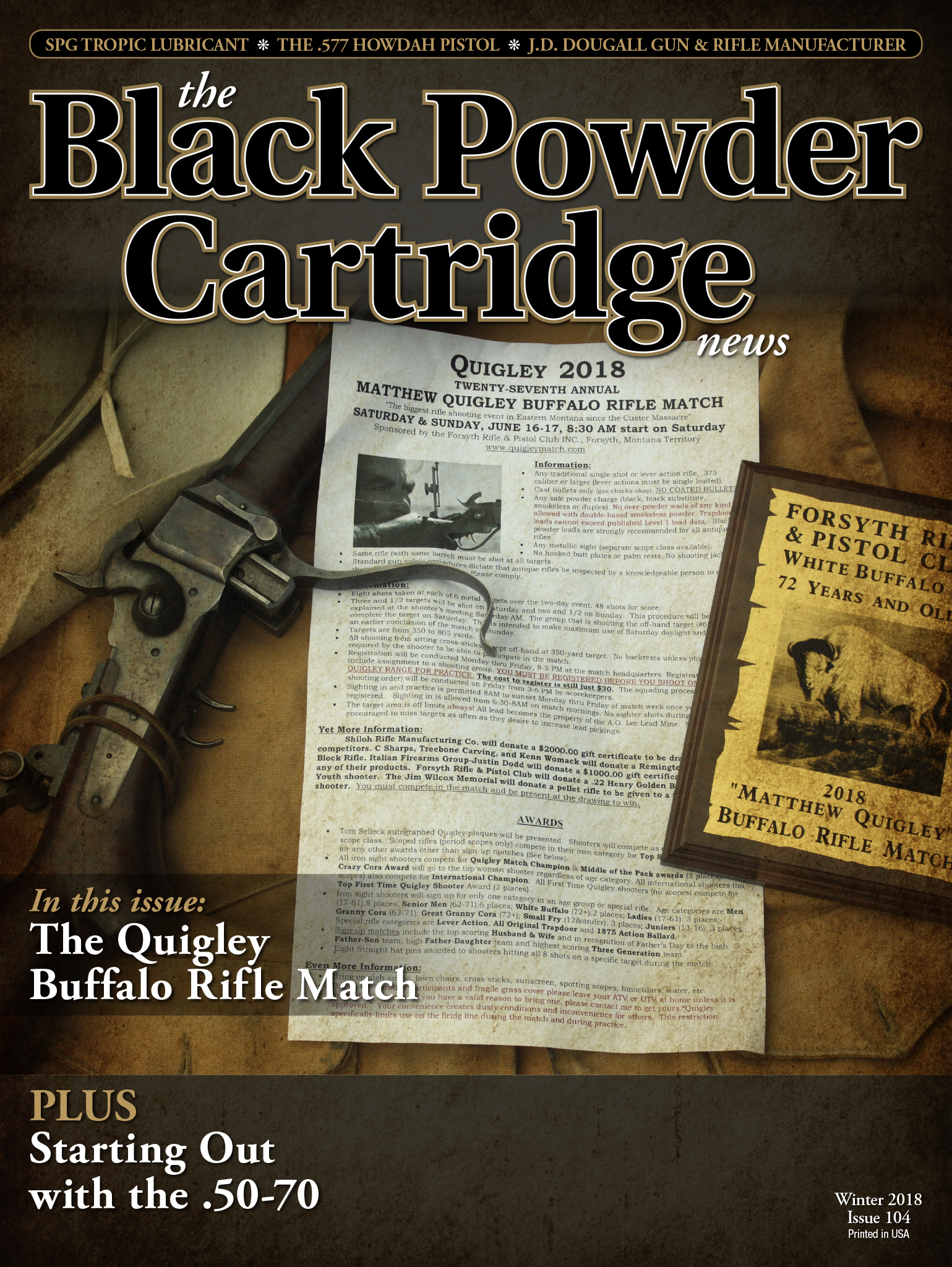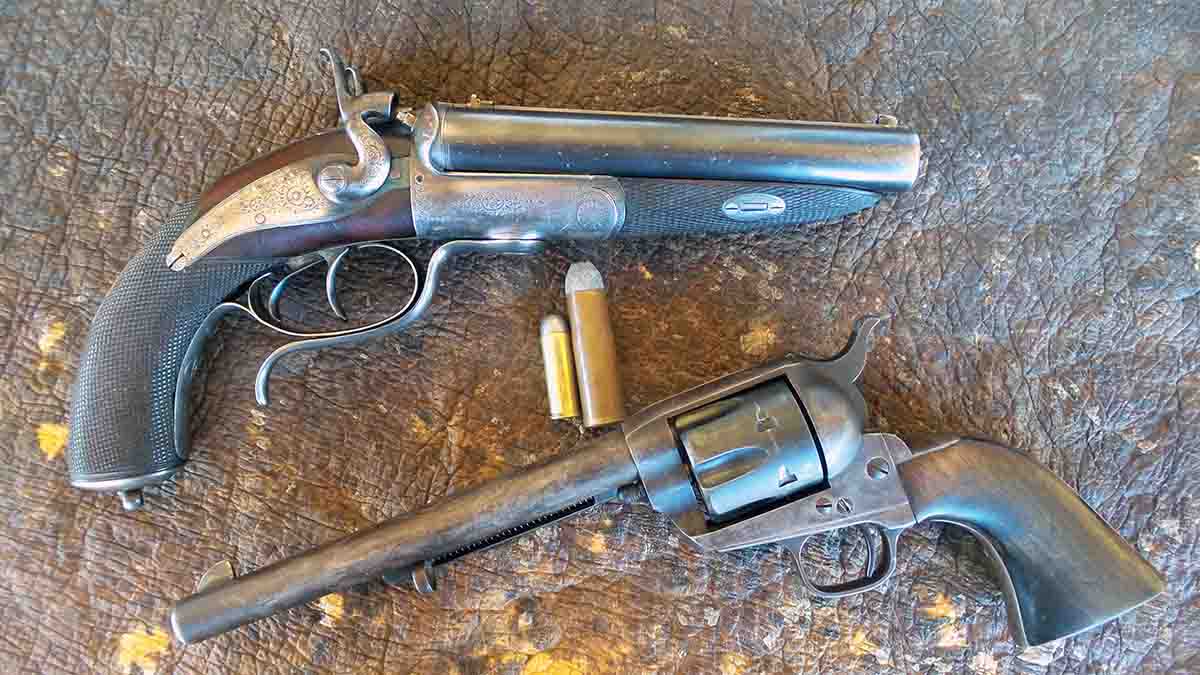
.577 Snider howdah pistol by Joseph Lang shown with a 1873 Colt Single Action Army revolver. The hippopotamus hide on which the .577 howdah was photographed was taken by the author in Tanzania in 2006, but was not shot with a howdah pistol!
If Harry Callahan from the movie Dirty Harry had carried a .577 howdah pistol by any one of the numerous makers in the United Kingdom, perhaps his reputation would have been a bit more famous. What do I mean by that? Well, just look at the photograph of the .577 Snyder cartridge and the .44 Magnum. A 240-grain bullet really can’t compare much to the 470-grain bullet in the larger round. How would Hollywood portray the bad guy on the football field if he was hit in the lower leg with the big howdah projectile? Need I say more?
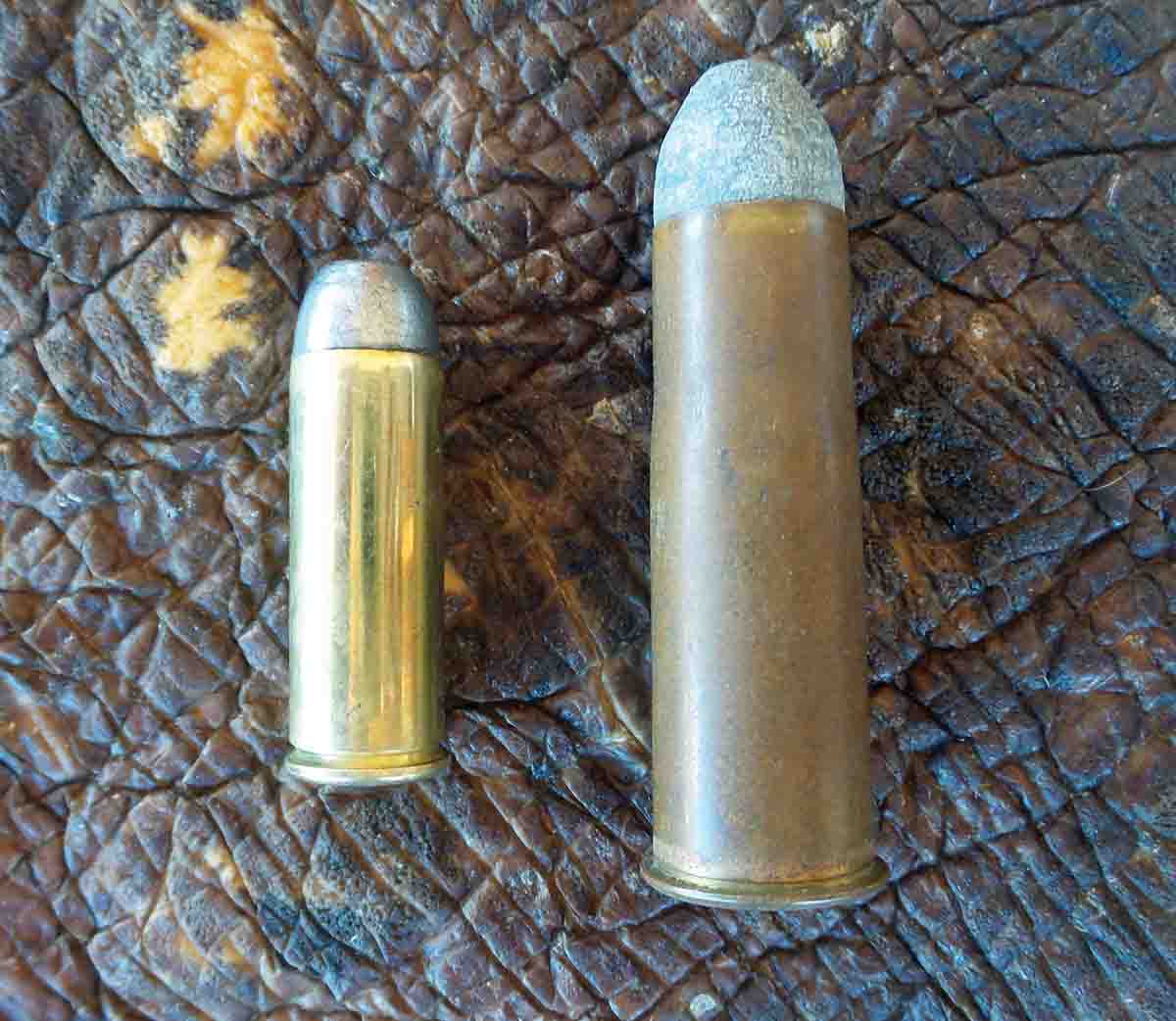
Shown are a (left) .44 Magnum cartridge and a .577 Snider.
The howdah pistol derived its name from the platform and basket on the back of the Indian elephant where hunters and guides rode in relative safety and comfort. Hunting for any game in the heat of the jungles of India was made a bit easier by riding atop an elephant while in a chair placed within the howdah. When the quarry could “hit back,” the howdah provided a level of safety that could not be had when on foot or on horseback. The howdah could be up to 10 feet above the ground. That height, combined with the immense size of an elephant, would assure the hunter would return at the end of the day – almost.
It is doubtful a wounded bear, gaur, or even a leopard would attack an elephant. It was a different story with a tiger, however. Tigers are the biggest member of the cat family and can be 1½ times the weight of an African lion. An attack from a wounded tiger could spell death to a hunter on foot. The situation could be almost as deadly atop an elephant. It was not uncommon for a wounded and angry tiger to leap up to the howdah to attack the hunter who caused him his pain. In fact, my 4-bore double rifle has engraving showing a tiger climbing up the head of an elephant to attack men in a howdah. The hunters have become the hunted!
After two shots have been fired from the hunter’s double rifle (either a .500 or .577-caliber black powder express, or a “bore” rifle in 10-, 8-, or 4-bore) there may not be time to reload as the lightning-quick and agile tiger leaps to the howdah. The last line of defense is the pistol. The .455 Webley and .45 Colt were too anemic to dispatch a 600-pound tiger full of adrenaline. Even the .577 Tanter revolver was too light to stop or even slow an angry tiger. Enter the double barrel (and sometimes four-barreled) howdah pistol.
Made with a side or top lever, or the more common Jones patent underlever system, the break-open design could accommodate cartridges larger in diameter
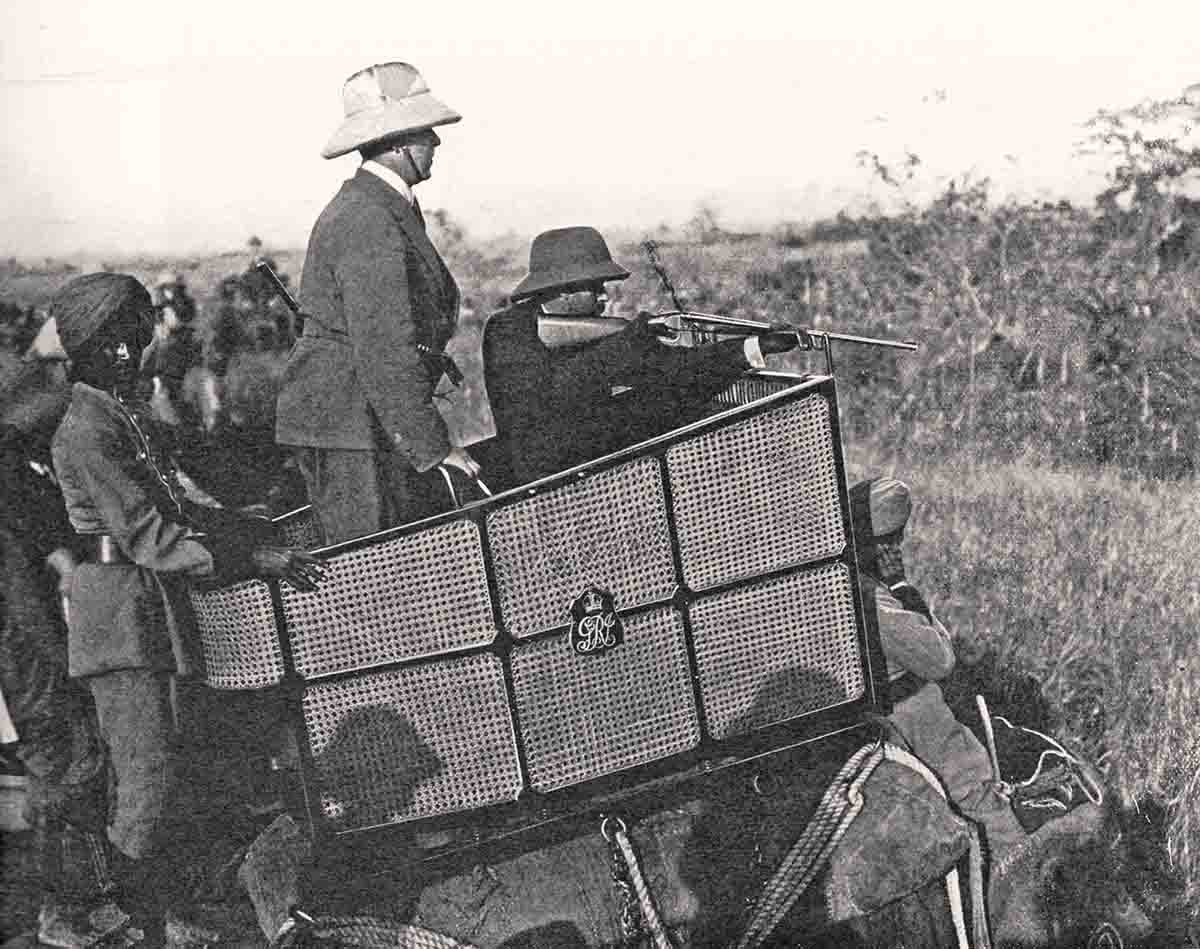
Hunting from the elephant howdah, Nepal, 1911.
and longer than the handguns of the day. Made in calibers .450, .500, .577 and in 20- and 16-bore, these double-barreled hand cannons filled the ticket for hunters looking for a “stopping” handgun. The .450s and .500s were also seen in four-barreled versions; the .577, 20s and 16s were limited to two barrels or sometimes a single shot, due to the diameter of the cartridge. An example of a double-barrel howdah was used by Michael Douglas, playing Remington, the hunter in the film The Ghost and the Darkness.
I have never been much of a fan of handguns. The only exception is a pair of .45 Colt Single Action Army revolvers I currently own. One is a first-generation from 1879 and the other is a third-generation that was purchased in 1981. Both have the standard fixed sights and 7½-inch barrel lengths. Nothing fits your hand like a Colt SAA!
A friend in Anchorage has an outstanding collection of howdah pistols in all calibers and gauge sizes, both two- and four-barreled styles. I have seen them when visiting his home and appreciate them as antiques and pieces of history that will never be seen again, but they never have sparked an interest. Even at the Alaska double-rifle shoots, a few howdahs are on display and attendees shoot them, as they do all the doubles there. I have participated with pleasure but not with enough interest to buy a howdah pistol. However, that was about to change.
In 2017, I purchased an original bullet mould in the huge 4-bore caliber. It was a conical mould with the hollow-point peg, and serial numbered to a Rodda 4-bore double rifle. I saw the rifle when it lived in Alaska many years ago. Then it went to Montana and later to a collector in Texas who soon grew
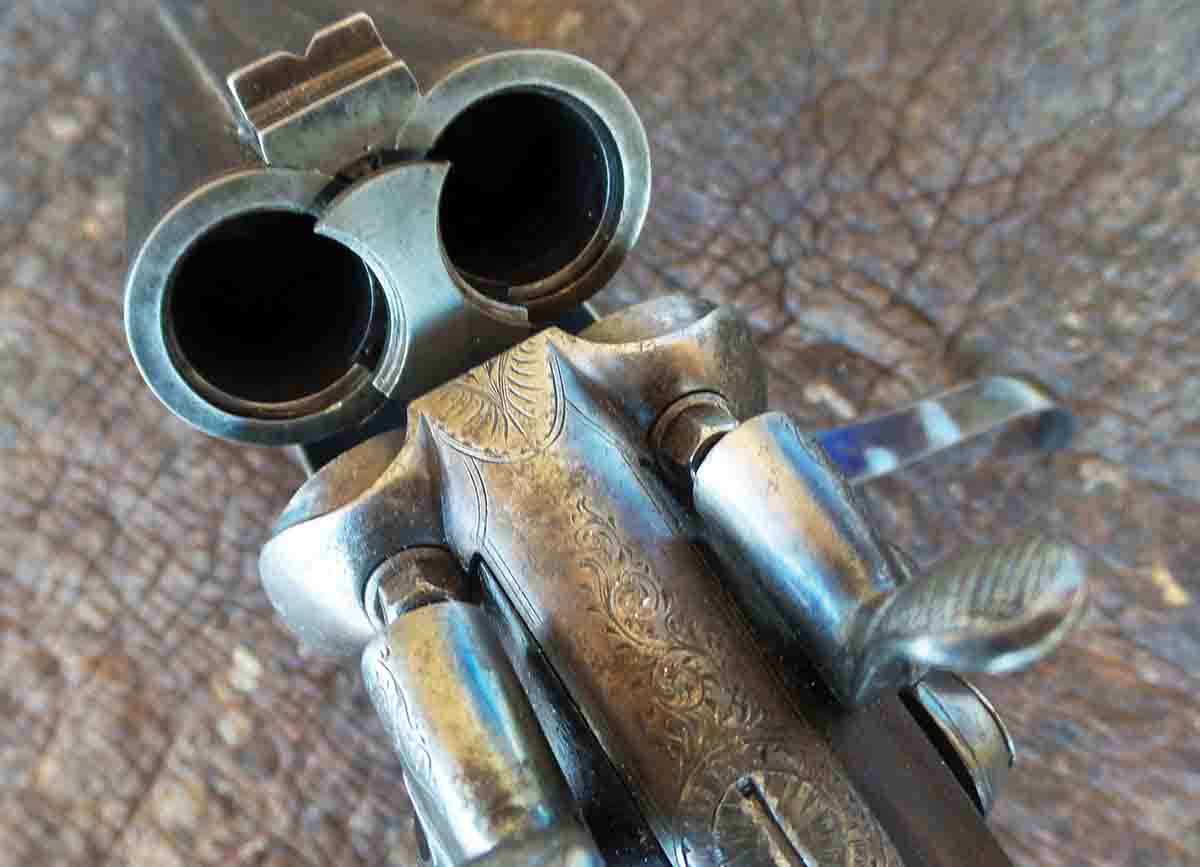
.577 Lang howdah pistol with breech open.
tired of it and passed it on to an auction company. The Rodda was then purchased by a collector in Europe. Years passed. When I bought the mould, I placed it on some forums to show it to others of like mind. About two weeks later, I received an email from the Rodda’s owner asking if I wanted to sell the mould – I really did not. He then offered me a trade of three moulds, all matching except for size in 10-, 8-, and 4-bore. My interest was not sparked as the moulds were from the Continent and not the UK, which is my only line of collecting and shooting.
Another email followed stating I had one week to make a decision. The offer was to trade a howdah pistol for the mould – straight across! While I was not too keen on a howdah, it was an offer too good to pass up. In the words of Don Corleone, he “made me an offer I could not refuse.” Having to give an answer within a week, I assumed the deal would be quickly consummated. The howdah was a pre-1899 antique and could be sent to me directly after a brief stop at U.S. customs to confirm its antique status. Not so in Europe, however. I had to pass a police background check to confirm I was not a felon. Then I had to apply for a permit to buy, and the seller had to apply for permit to sell. Then he had to apply for a permit to export, and a permit was issued to a shipping agent. After 10 months and a few hundred dollars, the howdah was ready to ship. The day of its arrival, I posted the mould to be reunited with the fabulous 4-bore Rodda. All parties were happy!

The Lang .577 howdah pistol featuring a Jones underlever locking system.
Upon examination of the howdah pistol, my expectations were not disappointed. Made by the firm of Joseph Lang, the pistol is chambered for the .577 Snider cartridge – the largest of the .577 chamberings at 2 inches in length. The barrels measured 63⁄8 inches with the forend held in place by a sliding wedge. The hammers are nonrebounding and the back-action locks are of the “peninsula” style. The hand grip has a recess for a shoulder stock but the stock has been lost to time. Two triggers complete the assembly. The barrels show 90 percent blacking remaining and the action and locks have traces of case color. The checkering on the wood remains sharp. Most importantly, the bore condition is excellent, being very bright with sharp rifling and zero pitting. While these pistols were made for very short-range shooting, interestingly the rear sight has a fixed leaf as well as a folding leaf for additional yardage. Distances are not marked on it, either. The serial number, which can’t be correct, is a single digit. The firm of Lang does not have a record of the date of manufacture, but the sliding wedge and the barrel address date the pistol to the late 1870s to early 1880s.
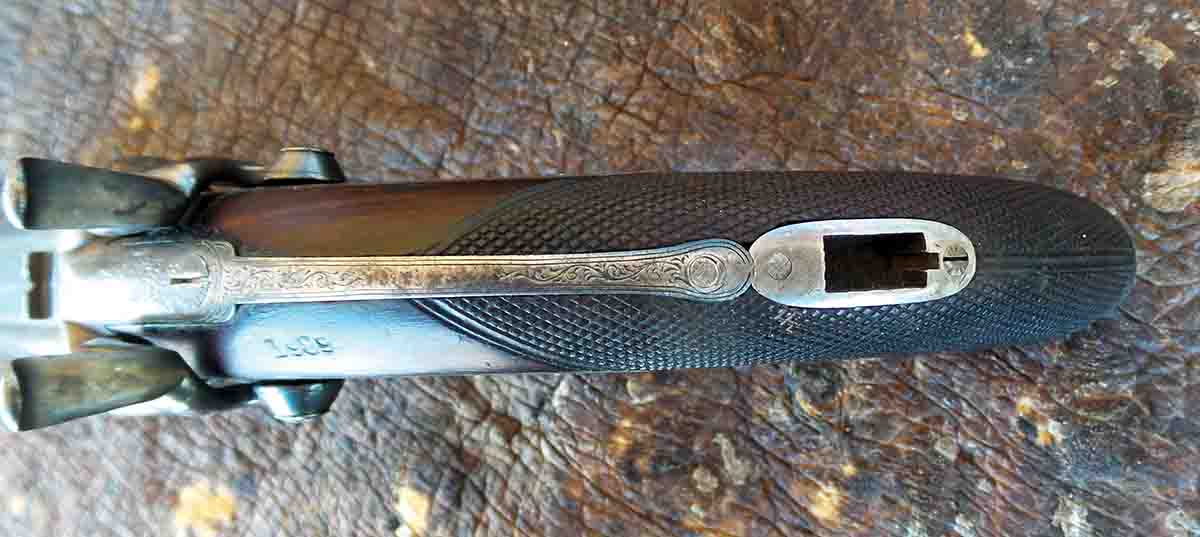
Shoulder stock attachment of the Lang.
After determining the bore diameter to be .585 inch and the case length via a chamber cast, reloading supplies were ordered. Dies and a shellholder were ordered from Dave Davidson at CH Tool (ch4d.com), as well as a ball mould for low-recoil shooting from Jeff Tanner in the UK. Lee Precision had a 480-grain hollow base mould just a bit over size at .590 inch, so soft lead would be used for casting. Brass cases were ordered from Huntington’s.
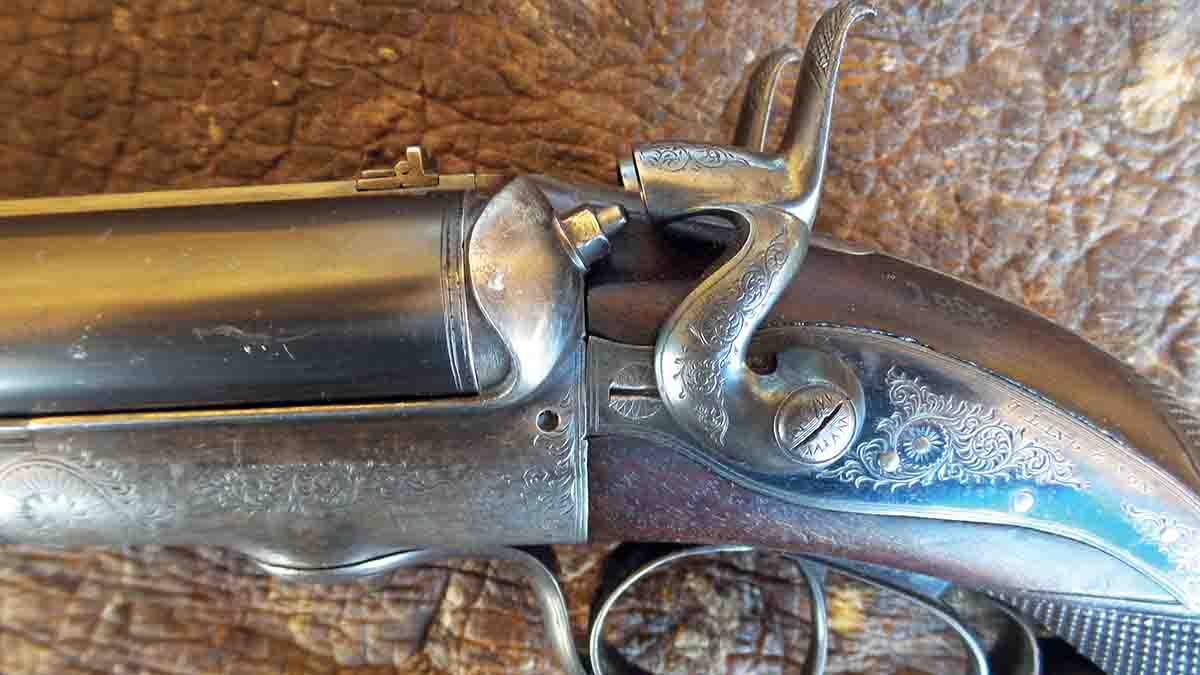
Engraved locks of the howdah pistol.
I keep my primer selection simple and use large rifle magnum primers whenever I shoot. My supply of black powder consisted of GOEX Fg, FFg and FFFg. I would also like to try smokeless powder after determining what burn rate would be best for the short barrels. I use IMR-4198 in my black powder express double rifles, but that powder may burn too slow to be effective in the short 6.375-inch barrels. A simple Chrony chronograph was used to measure velocity. With 70 grains of FFg, velocity was over 1,000 fps with a round ball and 775 fps with a conical bullet. Concerning accuracy, well, that’s kind of embarrassing, but it is more than adequate to shoot an angry tiger off the muzzles! Future load development is required to realize the potential of this big pistol.









